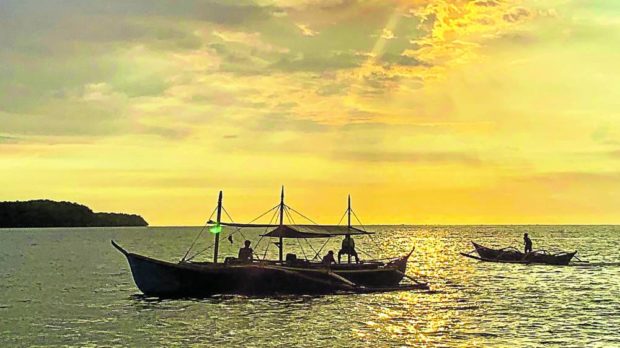
LIMITED TRIPS | Fishermen in Masinloc town, Zambales province, prepare their boats, gears and supplies for an early fishing trip in this photo taken on May 29, 2022. Many fishers in Zambales and nearby Pangasinan have been forced to limit their trips to reduce expenses as fuel prices soar. (File photo by JOANNA ROSE AGLIBOT / Inquirer Central Luzon)
SUAL, Pangasinan, Philippines — The skyrocketing prices of fuel are driving fishermen in this province out of business due to the huge expenses they incur on each fishing trip.
Andy Abata, 53, a fisherman from the island village of Cabalitian here, said they started limiting their operations due to the expensive diesel prices and the depleting catch.
“We no longer go on fishing trips on a daily basis. We have to cut back on our operations, especially now that there’s not much to catch and fuel price is so high,” Abata told the Inquirer.
Eduardo Bascao, 66, has also limited the use of his boat since it needs 15 liters of diesel for every fishing trip.
Bascao used to take his motorized boat up to the sea off Dagupan City and Binmaley town to catch “talakitok” (jackfish) and tuna when he could still afford the price of fuel.
“I can’t do it anymore. Life is more difficult now because of the rising fuel prices. If our catch is low, we have to wait two days to fish again,” Bascao said.
Angeles Mapanao, 78, another local fisherman, said he only managed to catch a kilo of fish on Tuesday after spending two liters of gasoline on his boat, noting that “it was not enough to get by.”
But for Alfredo Sendayen, 78, a fisherman from Barangay Estanza, in the capital town of Lingayen, he had no choice but to go fishing every day, otherwise “we would have nothing to eat.”
Sendayen uses 3 liters of gasoline every day to gather squid from his “paleg” (mini fish shelter) that yields only 2 kilos daily.
“Each kilo is sold for P300, so I would still have P300 left to take home to my family,” Sendayen said.
Subsidies
In Zambales province, fisherman and boat owner Felix Agasa, 66, of San Antonio town, said they suffered significant losses.
“A small fishing boat requires P600 to P800 worth of fuel to sail and catch Spanish mackerel and skipjack tuna, but sometimes fishermen come back empty-handed,” Agasa said.
To avoid incurring more losses, most fishermen avoid going farther out into the sea.
“But our income is still not decent enough to provide for our families because of the huge expense due to the high fuel prices,” Agasa said.
Two small fishing boats with five to eight fishermen on board need P1,000 worth of fuel to at least catch fish within the municipal waters.
“But traders will just buy our catch at a cheaper price. We can only take home P2,000 that will be divided into eight, and that’s only P250 for each fisherman per fishing trip,” Agasa said.
On Wednesday, groups of fishermen from Pangasinan and Zambales received P3,000 worth of fuel subsidy from the Bureau of Fisheries and Aquatic Resources to ease the impact of the price hike.
Situation in the Visayas
In Eastern Samar, Steve Ramboy, a tricycle driver in Borongan City, said he could not think of any way to support his family now that the price of diesel had breached the P100 mark in the province.
Ramboy, 56, and a father to two teenage boys, said half of his daily income of P200 now goes to fuel.
“Much I would like to stop driving while prices of gasoline is going up, I could not do it. I have to attend to the daily needs of my family,” he said.
Ramboy said his family needed at least P500 a day to be able to eat a decent meal thrice a day.
Eastern Samar Gov. Ben Evardone said the price of diesel in some parts of the province reached P101 per liter.
Prices in other major cities in Eastern Visayas, including Tacloban City in Leyte; Catbalogan and Calbayog cities, both in Samar; and Maasin City in Southern Leyte, now ranged from P85 to P99.99 per liter.
“I have called the Department of Trade and Industry to look into this. The high cost of fuel will definitely have an impact on all sectors,” Evardone said.
In Metro Cebu, at least 50 public utility vehicle drivers have stopped plying their routes amid the continuing rise of fuel costs.
Greg Perez, coordinator of the transport group Piston in Cebu, said some of their members decided to return to their respective provinces to find other jobs.
“As we can see, fuel prices have been soaring. Our drivers will really give up. Some of our members have opted to apply as family drivers, company drivers, or delivery drivers,” Perez said in an interview.
—REPORTS FROM YOLANDA SOTELO, JOANNA ROSE AGLIBOT, JOEY GABIETA AND DALE ISRAEL
RELATED STORIES
Vegetable traders see more losses with high fuel cost
Additional P600-M fuel subsidy for farmers, fishers
26,000 provincial bus workers lose jobs due to rising fuel prices